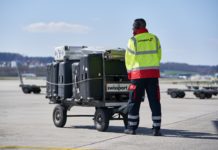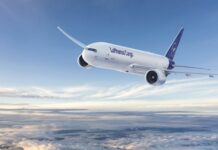

Textron’s session on the SkyCourier was so popular it had to be moved to the main conference hall but that is not surprising.
Considering how many Cessna aircraft are in some sort of commercial commuter or cargo service, it is no surprise Textron Aviation is pursuing a dual certification track for both the freighter and passenger variants of the Cessna 408 SkyCourier, which are listed at $5.5M and $6.3M, respectively. The Cessna SkyCourier, in its passenger variant, is the first clean-sheet, 19-passenger commuter aircraft in decades.
“This is the first clean-sheet aircraft to undergo the new FAR Part 23 certification since the FAA published new rules,” said Mike Haenggi, manager fleet sales, who added the Cessna SkyCourier, with a 100-aircraft order from FedEx, will be the largest aircraft in Textron Aviation’s turboprop lineup. “The new rules help standardize certification across aviation authorities around the world so once it is FAA certificated, we expect additional international markets to open quickly. The whole idea of the change was to get away from the specific weights in favor of standards based on the number of passengers and the aircraft’s performance. The Cessna SkyCourier falls into two levels under the new rules: level one for freighters and level four for passengers. Both variants are being designed in parallel where applicable, providing a simple, robust and reliable platform for either customer need. It’ll be a workhorse.”
Haenggi briefed RACCA attendees on the Cessna SkyCourier freighter specifications, including a large cargo door, a loading height only 42 inches above the ground, and a maximum payload of 6,000 lb, with the ability to handle three LD3 containers. The freighter variant will also be certified for single-pilot operations.
The unpressurized passenger variant has a sweet spot range of 400 nm at 200 ktas cruise speed and is powered by a Pratt & Whitney-Canada P&WC PT6A-65SC engine, using aluminum props from McCauley. The engines are 1,110 shp and specifically designed for low altitude, high cycle operations. It will have a 6,000-hour TBO on service entry along with optional automated wireless data transmission.
“We are designing it like an airliner, with composite-material sidewalls and USB ports at each passenger seat,” he said, adding that overhead bins will be installed along one side of the aircraft. “It will withstand the wear of day-to-day operations in rugged environments as well. Our in-house designed leather seats are lightweight, but durable, providing an enjoyable passenger experience for every flight condition.”
Textron Aviation is also nearing fuselage completion on the Cessna Denali prototype, powered by the GE Aviation Catalyst, a 1300 shp engine, which has undergone more than 1,000 hours of testing. The engine and 105-inch McCauley composite propeller are FADEC controlled and in combination with the touchscreen G3000 avionics, work to reduce pilot workload and provide a greater overall flight experience. With a range of 1,600 nm, the Cessna Denali is designed for quick conversions between the six-passenger interior, nine-passenger commuter or cargo variant. The aircraft includes a 53- by 58-inch rear cargo door and optional externally serviced lavatory.










